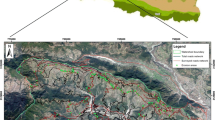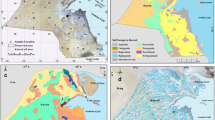Abstract
Off-road vehicles can have a devastating impact on vegetation and soil. Here, we sought to quantify, through a combination of field vegetation, bulk soil, and image analyses, the impact of off-road vehicles on the vegetation and soils of Rawdat Al Shams, which is located in central Saudi Arabia. Soil compaction density was measured in the field, and 27 soil samples were collected for bulk density analysis in the lab to quantify the impacts of off-road vehicles. High spatial resolution images, such as those obtained by the satellites GeoEye-1 and IKONOS-2, were used for surveying the damage to vegetation cover and soil compaction caused by these vehicles. Vegetation cover was mapped using the Normalized Difference Vegetation Index (NDVI) technique based on high-resolution images taken at different times of the year. Vehicle trails were derived from satellite data via visual analysis. All damaged areas were determined from high-resolution image data. In this study, we conducted quantitative analyses of vegetation cover change, the impacts of vehicle trails (hereafter “trail impacts”), and a bulk soil analysis. Image data showed that both vegetation cover and trail impacts increased from 2008 to 2015, with the average percentage of trail impacts nearly equal to that of the percentage of vegetation cover during this period. Forty-six species of plants were found to be present in the study area, consisting of all types of life forms, yet trees were represented by a single species, Acacia gerrardii. Herbs composed the largest share of plant life, with 29 species, followed by perennial herbs (12 species), grasses (5 species), and shrubs (3 species). Analysis of soil bulk density for Rawdat Al Shams showed that off-road driving greatly impacts soil density. Twenty-two plant species were observed on the trails, the majority of which were ephemerals. Notoceras bicorne was the most common, with a frequency rate of 93.33 %, an abundance value of 78.47 %, and a density of 0.1 in transect 1, followed by Plantago ovata.







Similar content being viewed by others
References
AASHTO. (2006). American association of state highway and transportation officials. Density of soil in-place by the sand-cone method, AASHTO, Designation: T 191-02 (2006).
Al Nafie, A. (2007). The effect of off-road driving on the plant cover of natural recreational areas in central of Saudi Arabia. Saudi Journal of Biological Sciences, 14, 53–72.
Anderson, A. B., Wang, G., Fang, S., Gertner, G. Z., Guneralp, B., & Jones, D. (2005). Assessing and predicting changes in vegetation cover associated with military land use activities using field monitoring data at Fort Hood, Texas. Journal of Terramechanics, 42, 207–229.
Angold, P. G. (1997). The impact of a road upon adjacent heathland vegetation: effects on plants species composition. Journal of Applied Ecology, 34(2), 409–417.
ASTM (2006) Standard test method for permeability of granular soils (Constant Head). Designation: D2434-68 (Reapproved 2006).
Buckley, D. S., Crow, T. R., Nauertz, E. A., & Schulz, K. E. (2003). Influence of skid trails and haul roads on understory plant richness and composition in managed forest landscapes in Upper Michigan, USA. Forest Ecology and Management, 175, 509–520.
Chaudhary, S. (1989). Grasses of Saudi Arabia (p. 465). Riyadh: Ministry of Agri. & Water.
Chaudhary, S. (1999). Flora of the Kingdom of Saudi Arabia (Vol. 1-III). Riyadh: Ministry of Agriculture & Water.
Collenette, I. S. (1999). Wildflowers of Saudi Arabia (p. 799). Riyadh: National Commission for Wildlife Conservation.
Donaldson, A., Bennett, A. (2004). Ecological effects of roads: implications for the internal fragmentation of Australian parks and reserves parks Victoria technical series No. 12. Parks Victoria, Melbourne.
ERDAS (2015). Intergraph® corporation is part of Hexagon (Nordic exchange: HEXA B).
Godefroid, S., & Koedam, N. (2004). The impact of forest paths upon adjacent vegetation: effects of the path surfacing material on the species composition and soil compaction. Biological Conservation, 119, 405–419.
Goran, W. D., Radke, L. L., Severinghaus, D. W. (1983). An overview of the ecological effects of tracked vehicles on major US Army installations. United States Army Construction Engineering Research Laboratory, Technical Report, N-142, Champaign, IL.
Hirst, R. A., Pywell, R. F., & Putwain, P. D. (2000). Assessing habitat disturbance using historical perspective: the case of Salisbury Plain military training area. Journal of Environmental Management, 60, 181–193.
Hogda, K. A., & Johansen, B. (2004). High resolution satellite images for detecting vegetation damage caused by terrain vehicles in Northern Norway. IEEE, 2, 2286–2289.
Kindermann, G., & Gormally, M. J. (2010). Vehicle damage caused by recreational use of coastal dune systems in a Special Area of Conservation (SAC) on the west coast of Ireland. Journal of Coast Conservation, 14, 173–188.
Lacey, C. A., Lacey, J. R., Fay, P. K., Storey, J.M., and Zamora, D. L. (1997). Controlling knapweed on Montana Rangeland. Montana State University Extension Service Circular 311.
Lathrop, E. W., & Rowlands, P. G. (1983). Plant ecology in deserts: an overview. In R. H. Webb & H. G. Wilshire (Eds.), Environmental effects of off road vehicles: impacts and management in arid regions (pp. 114–153). New York: Springer-Verlag.
Luckenbach, R. A., & Bury, R. B. (1983). Effects of off-road vehicles on the biota of the Algodones dunes, Imperial County, California. The Journal of Applied Ecology, 20(1), 265–286.
Lucrezi, S., & Schlacher, T. A. (2010). Impacts of off-road vehicles (ORVs) on burrow architecture of ghost crabs (genus Ocypode) on sandy beaches. Environmental Management, 45, 1352–1362.
Mandaville, J. P. (1990). Flora of Eastern Saudi Arabia. Riyadh: Kegan Paul, London and NCWCD.
Ministry of Agriculture and Water. (1993). Land investment management. Riyadh: Land Resources Atlas.
Price, M. F. (1983). Management planning in the Sunshire Area of Canada’s Banff National Park. Parks, 4, 6–10.
Priskin, J. (2003). Physical impacts of four-wheel drive related tourism and recreation in a semi-arid natural coastal environment. Ocean and Coastal Management, 46, 127–155.
Richter, R., and Schläpfer, D. (2014). Atmospheric / topographic correction for satellite imagery, DLR report DLR-IB 565-02/14, Wessling, Germany, pp. 231.
Schlacher, T. A., & Thompson, L. M. C. (2008). Physical impacts caused by off-road vehicles to sandy beaches: spatial quantification of car tracks on an Australian Barrier Island. Journal of Coastal Research, 24(2B), 234–242.
Shaltout, K. H., & Mady, M. A. (1996). Analysis of Rawdat vegetation in Central Saudi Arabia. Journal of Arid Environment, 34, 441–454.
Sparrow, S. D., Wooding, F. J., & Whiting, E. H. (1978). Effects of off-road vehicle traffic on soils and vegetation in the Denali highway region of Alaska. Journal of Soil Water Conservation, 1, 20–27.
Stephenson, G. (1999). Vehicle impacts on the biota of sandy beaches and coastal dunes—a review from a New Zealand perspective (Science for conservation 121). Wellington: Department of Conservation.
Trumbull, V. L., Dubois, P. C., Brozka, R. J., & Guyette, R. (1994). Military camping impacts on vegetation and soils of the Ozark Plateau. Journal of Environmental Management, 40, 329–339.
Washington-Allen, R. A., Ramsey, R. D., West, N. E., & Norton, B. E. (2008). Quantification of the ecological resilience of drylands using digital remote sensing. Ecology and Society, 13(1), 33. URL: http://www.ecologyandsociety.org/vol13/iss1/art33/.
Web, R. H. (1983). Compaction of desert soils by off road vehicles. In R. H. Webb & H. G. Wilshire (Eds.), Environmental effects of off road vehicles: impacts and management in arid regions (pp. 51–79). New York: Springer-Verlag.
Webb, R. H., & Wilshire, H. G. (1983). Environmental effects of off-road vehicles—impacts and management in arid regions. New York, NY: Springer-Verlag.
Wilshire, H. G., Shipley, S., & Nakata, J. K. (1978). Impacts of off-road vechicles on vegetation. Transactions of the North America Wildlife and Natural Resources Council, 43, 131–139.
Acknowledgments
The authors would like to thank the National Plan for Science, Technology, and Innovation of the Kingdom of Saudi Arabia, for funding this project (12-ENV2776-08). The authors would like to thank Prof. Abdullatif H. Al-Nafie for his logistics contribution. We would also like to thank the technical team who shared their expertise in this project.
Author information
Authors and Affiliations
Corresponding author
Rights and permissions
About this article
Cite this article
Dewidar, K., Thomas, J. & Bayoumi, S. Detecting the environmental impact of off-road vehicles on Rawdat Al Shams in central Saudi Arabia by remote sensing. Environ Monit Assess 188, 396 (2016). https://doi.org/10.1007/s10661-016-5400-6
Received:
Accepted:
Published:
DOI: https://doi.org/10.1007/s10661-016-5400-6




